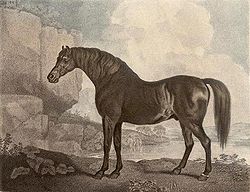Marske
| Marske | |
 Marske |
|
| Race: | English blood |
| Father: | Squirt |
| Mother: | Ruby mare |
| Mother, father: | Blacklegs |
| Gender: | stallion |
| Year of birth: | 1750 |
| Year of death: | 1779 |
| Country: | |
| Colour: | brown |
| Breeder: | John Hutton |
| Owner: | William Augustus, Duke of Cumberland , William Wildman, Willoughby Bertie, 4th Earl of Abingdon |
Marske (* 1750; † July 1779) was a racehorse of the English thoroughbred breed . Today he is best known because he is the descendant of the exceptional horse Eclipse , which plays a significant role in the history of the English thoroughbred. It takes its name from Marske, Richmondshire , where he was born.
ancestry
Marske descends in direct paternal line from Darley Arabian , one of the three main founding fathers of the English thoroughbred breed today. The stallion was imported from Syria to Aldby Park , Buttercrambe , in 1704 by the English merchant Thomas Darley . Marske's grandfather, in technical terms the second father in the paternal line, is Bleeding Childers , a son of Darley Arabian who never ran because he began to bleed from his nostrils with greater exertion. This stallion, however, was a full brother of the much more successful racehorse Flying Childers . While this was inaccessible to most breeders at the stud of his owner Duke of Devonshire after his racing career was over, John Bartlett, the owner of Bleeding Childers, took a comparatively low stud fee. Squirt , who emerged from a mating of this stallion with the mare "Sister to Old Country Wench" and is the father of Marske, was a reasonably successful racehorse.
Marske's breeder was John Hutton, one of the early and influential breeders of the English thoroughbred, who exchanged the stallion as a foal for an Arab owned by William Augustus, Duke of Cumberland .
Racing career
Marske ran a total of six races, of which he won three. He was twice defeated by the stallion Snap , whose third father in the paternal line was Flying Childers.
| date | Distance in miles | Racetrack | price | Number of starters | placement | Competitors |
|---|---|---|---|---|---|---|
| April 1754 | unknown | Newmarket | 40 guineas | unknown | 1 | Mr. Cornwall's Gray Colt |
| May 8, 1754 | 3m 5f | Newmarket | 100 guineas | 5 | 1 | Pythos; Brilliant; Ginger; Bear |
| October 1754 | 4m 1.5f | Newmarket | 300 gs | 2 | 1 | Ginger |
| April 1755 | unknown | Newmarket | unknown | 3 | 3 | Brilliant; Siphon |
| April 1756 | unknown | Newmarket | 1,000 guineas | 2 | 2 | Snap |
| May 1756 | unknown | Newmarket | 1,000 guineas | 2 | 2 | Snap |
| October 1756 | unknown | Newmarket | unknown | 2 | given up | Spectator |
Breeding stallion
Marske was on the Duke's stud until the Duke of Cumberland's death in 1765. After his death he was sold at a Tattersall auction for a comparatively small amount to a farmer from Dorset, where he covered half a guinean mares for a comparatively low stud fee. It was then sold to William Wildman for 20 guineas. Even before Marske's son Eclipse ran his first successful races, Wildman was able to increase the stud fee to just over 30 guineas. Wildman finally sold the stallion to the Earl of Abingdon , who, given the great success of Eclipse, was able to take stud fees of 100 guineas. In 1775 and 1776 Marske was champion of sire horses in England and Ireland .
literature
- Christopher McGrath: Mr. Darley's Arabian - High Life, Low Life, Sporting Life: A History of Racing in Twenty-Five Horses . John Murray, London 2016, ISBN 978-1-84854-984-5 .
- Rainer L. (editor in chief) Ahnert: Thoroughbred Breeding of the World . Pozdun Publishing, Germany 1970.
- James Christie Whyte: History of the British Turf, from the earliest period to the present day, Volume I . H. Colburn, London 1840 (Retrieved May 1, 2013).
Individual evidence
- ↑ McGrath: Mr. Darley's Arabian . E-book position 930
- ↑ science.orf.at ( Memento of the original from March 11, 2007 in the Internet Archive ) Info: The archive link was inserted automatically and has not yet been checked. Please check the original and archive link according to the instructions and then remove this notice.
- ↑ 95% of thoroughbreds linked to one superstud . In: New Scientist , September 20, 2005.
- ↑ McGrath: Mr. Darley's Arabian . E-book position 930
- ↑ Whyte, p. 462